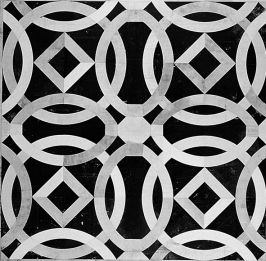The
Hidden Pavement Designs of the Laurentian Library
Ben Nicholson
Illinois Institute of Technology, USA
Jay Kappraff
New Jersey Institute of Technology, USA
Saori Hisano
Illinois Institute of Technology, USA
 "In
1774, a portentous accident occurred in the Reading Room of the
Laurentian Library, designed by Michelangelo. The shelf of desk
74, overladen with book, gave way and broke. During the course
of its repair, workmen found a red and white terra cotta
pavement hidden for nearly 200 years beneath the floorboards.
The librarian had trapdoors, still operable today, built into
the floor so future generations could view these unusual pavements.
In 1928 another mishap resulted in the exposure of the entire
pavement, which allowed photographs to be made of the fifteen
panels on the West side of the library before the wooden floor
was replaced.
"In
1774, a portentous accident occurred in the Reading Room of the
Laurentian Library, designed by Michelangelo. The shelf of desk
74, overladen with book, gave way and broke. During the course
of its repair, workmen found a red and white terra cotta
pavement hidden for nearly 200 years beneath the floorboards.
The librarian had trapdoors, still operable today, built into
the floor so future generations could view these unusual pavements.
In 1928 another mishap resulted in the exposure of the entire
pavement, which allowed photographs to be made of the fifteen
panels on the West side of the library before the wooden floor
was replaced.
Overall the pavement consists
of two side aisles and a figurative center aisle. Each measuring
about 8'-6" square and composed of a different design. The
fifteen panels mirror each other's form but differ by a very small
degree and in subtle ways. When juxtaposed in a series, the fifteen
pairs of panels appear to tell a story about the essentials of
geometry and numbers. Each panel settles upon a theme: the tetractys
(panel 5); Brunés' star and the Sacred Cut (panels 7 and
11); Plato's lambda (panel 14); the Golden Mean (Panel
13). When assembled together they form an encyclopedia of the
essential principles handed down from ancient geometers.
Although they are hidden from
view today, Nicholson believes that the panels were laid according
to a plan for a furniture layout that would have exposed them,
but that this plan was changed after the panels had been made.
He suggests that the original intention was to infuse the spectator
with the foundations of ancient geometry as he walked through
the Reading Room of the Laurentian Library, the geometry being
a perfect complement for the 3000 classical texts chosen to reveal
the body of ancient and modern living."
Order the book Nexus II: Architecture
and Mathematics
|
abstract index | previous
| next | NNJ
homepage | e-mail
Ben Nicholson | e-mail Jay
Kappraff | top of page
 "In
1774, a portentous accident occurred in the Reading Room of the
Laurentian Library, designed by Michelangelo. The shelf of desk
74, overladen with book, gave way and broke. During the course
of its repair, workmen found a red and white terra cotta
pavement hidden for nearly 200 years beneath the floorboards.
The librarian had trapdoors, still operable today, built into
the floor so future generations could view these unusual pavements.
In 1928 another mishap resulted in the exposure of the entire
pavement, which allowed photographs to be made of the fifteen
panels on the West side of the library before the wooden floor
was replaced.
"In
1774, a portentous accident occurred in the Reading Room of the
Laurentian Library, designed by Michelangelo. The shelf of desk
74, overladen with book, gave way and broke. During the course
of its repair, workmen found a red and white terra cotta
pavement hidden for nearly 200 years beneath the floorboards.
The librarian had trapdoors, still operable today, built into
the floor so future generations could view these unusual pavements.
In 1928 another mishap resulted in the exposure of the entire
pavement, which allowed photographs to be made of the fifteen
panels on the West side of the library before the wooden floor
was replaced.